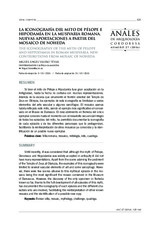Mostrar el registro sencillo del ítem
La iconografía del mito de Pélope e Hipodamía en la musivaria romana. Nuevas aportaciones a partir del mosaico de Noheda
| dc.contributor.author | Valero Tévar, Miguel Ángel | |
| dc.date.accessioned | 2018-01-15T11:28:14Z | |
| dc.date.available | 2018-01-15T11:28:14Z | |
| dc.date.issued | 2016 | |
| dc.identifier.issn | 1130-9741 | |
| dc.identifier.uri | http://hdl.handle.net/10396/15834 | |
| dc.description.abstract | Si bien el mito de Pélope e Hipodamía tuvo gran aceptación en la Antigüedad, hasta la fecha no contaba con muchas representaciones. Además de la escena que ornamentó el frontón oriental del Templo de Zeus en Olimpia, los ejemplos de esta iconografía se limitaban a varios elementos del arte vascular y algunos sarcófagos. El mosaico apenas habría reflejado este mito, siendo el ejemplo más significativo el conservado en el Museo de Damasco. El descubrimiento en Noheda del único ejemplar conocido hasta el momento con el desarrollo secuencial íntegro de todos los episodios del mito, ha permitido documentar la iconografía de cada episodio y de los diferentes personajes que lo protagonizan, facilitando la reinterpretación de otros mosaicos ya conocidos y la identificación de un posible nuevo ejemplar. | es_ES |
| dc.description.abstract | Until recently, it was considered that although the myth of Pelope, Oenomaus and Hippodamia was widely accepted in antiquity it did not have many representations. Apart from the scene adorning the pediment of the Temple of Zeus at Olympia, the examples of this iconography were limited to several vascular elements of art and some sarcophagi. However, there were few scenes allusive to this mythical episode in the mosaics being the most significant the mosaic conserved in the Museum of Damascus. However, the discovery of the only specimen in Noheda known so far, thanks to the full development of all episodes of this myth, has documented the iconography of each episode and the different characters who are involved, facilitating the reinterpretation of other known mosaics and the identification of a possible new copy. | es_ES |
| dc.format.mimetype | application/pdf | es_ES |
| dc.language.iso | spa | es_ES |
| dc.publisher | Universidad de Córdoba, Área de Arqueología | es_ES |
| dc.rights | https://creativecommons.org/licenses/by/3.0/ | es_ES |
| dc.source | Anales de Arqueología Cordobesa 27, 125-160 (2016) | es_ES |
| dc.subject | Villa romana | es_ES |
| dc.subject | Mosaico | es_ES |
| dc.subject | Mitología | es_ES |
| dc.subject | Reto | es_ES |
| dc.subject | Cuadriga | es_ES |
| dc.subject | Roman villa | es_ES |
| dc.subject | Mosaic | es_ES |
| dc.subject | Mythology | es_ES |
| dc.subject | Challenge | es_ES |
| dc.subject | Quadriga | es_ES |
| dc.title | La iconografía del mito de Pélope e Hipodamía en la musivaria romana. Nuevas aportaciones a partir del mosaico de Noheda | es_ES |
| dc.title.alternative | The iconography of the myth of Pelope and Hippodamia in roman musivaria. New contributions from mosaic of Noheda | es_ES |
| dc.type | info:eu-repo/semantics/article | es_ES |
| dc.relation.publisherversion | https://www.uco.es/ucopress/ojs/index.php/anarcor/index | es_ES |
| dc.rights.accessRights | info:eu-repo/semantics/openAccess | es_ES |

